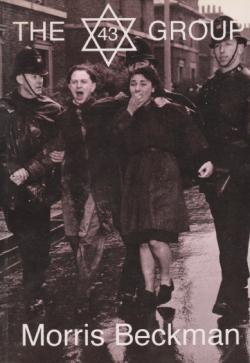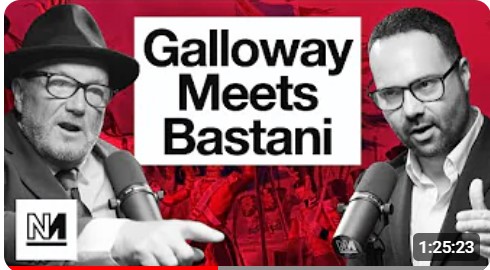By John Pickard
Anyone acquainted with the famous advice of Leon Trotsky, that in dealing with fascists we should “acquaint their heads with the pavement”, will be inspired by Morris Beckman’s book, The 43 Group. They will not only be uplifted but also educated about a part of British post-war history that even many baby-boomers know little about.
The book is an account of the formation of a dedicated group of mostly Jewish ex-service men and women, organised with the specific aim of driving fascists off the streets of East London and other cities.
Fascists interned in Second World War
It is not commonly known, but fascism in Britain went through something of a temporary resurgence after the Second World War. Most fascists, and notably their leader Oswald Moseley, were interned for most of the war years under the so-called 18b Regulation. But when the war was over, they were free to peddle their filth again on the streets and they took full advantage of the tolerance of the law. Among these people, having an 18b record was a badge of honour and when they started to meet and publish material again, it was with the same old anti-Semitic themes, occasionally dressed up as ‘anti-alien’ rhetoric.
They fed on the hardships and austerity faced by working class people in what were extremely difficult years. The winter of 1946-47, for example, was one of the coldest on record, with the government even unable to move coal stocks that were frozen solid, leading to intermittent power cuts. Unemployment rocketed up from 400,000 to 1.75m. Rationing was still in force and there was still a shortage of accommodation after wartime damage to housing stock; the fascists then, as they do now, blamed all the hardships on ‘aliens’, specifically Jews, and they found some echo among the middle class and more backward workers.
Former German POWs joined British fascists
The fascists were allowed to operate openly and at their peak were able to hold regular street sales of their literature, hold marches and hold street and indoor meetings, sometimes several times a week. The Ridley Road Market in Bethnal Green was one of their favour pitches. Astonishingly, they included in their ranks – often as ‘heavies’ to protect meetings – ex-German prisoners of war, who had obviously blagged their way through their ‘de-Nazification’ programmes. One of their notorious thugs was a former SS prisoner. The ongoing war in Palestine was grist to the mill for the fascists, who fed on stories of atrocities committed by the right-wing Jewish paramilitary group the Irgun, at war with British forces in Palestine.
Despite the horrors of the Nazi extermination camps now being generally known and having been seen in all their graphic horror in cinema newsreels, the fascists aimed their activity in areas with a high population of Jewish people. At their peak, they were able to sell papers in many parts of East London (and in the provinces) and hold marches and rallies, sometimes attracting crowds of hundreds or even thousands when the ‘great leader’ Moseley was speaking.
Faced with the growing threat of fascism and having Jewish men and women assaulted in the streets by fascist thugs, a number of mainly Jewish ex-service personnel got together. These were no callow youths – they were tough, hardened soldiers, sailors and airmen, some of whom had war wounds to prove it, and many of them had been decorated for bravery. They decided that enough was enough. They put the word around and had an initial meeting attended by 43 people – and that gave the group its name – and they decided to get organised. Beckman himself was a founding member.
Many groups of workers fought fascism
The 43 group weren’t alone in tackling the fascists, and Beckman doesn’t pretend they were. In almost every confrontation with the fascists, they had allies, including local trade unionists – often organised through trades councils – Communist Party members and, not least, local residents who came out to have a go at the blackshirts. Some of these allies, in fact, had already been physically confronting the fascists before the 43 Group took off.
From an initial 43 members, the Group grew massively. In the end, it had hundreds of members, organised into local groups – Beckman calls them ‘commandos’ – with their own headquarters and full-time staff. It had an ‘intelligence’ section that coordinated information from spies they sent into the fascist groups – quite dangerous work – and which planned raids on meetings and rallies.
Vidal Sassoon is known to today’s older generation as a former coiffeur to the rich and famous, including Hollywood stars; he was even given a CBE by the queen. Not many people know, however, that he was also one of the youngest members of the 43 Group and when asked, he was happy to write a foreword for Beckman’s book. Other famous financial supporters were Bud Flanagan, the music hall entertainer and Jack Solomons, the boxing promoter. Many other Jewish business people and celebrities gave money. The son of Konni Zilliacus, Gateshead’s Labour MP, was a member.
“It became an impressively effective operation and in July 1947, in a meeting with the Board [of Jewish Deputies], the group’s executive declared they had over 500 members and an operating budget for the coming year of £30,000 (over a million pounds in today’s money)” (From We Fight Fascists, by Daniel Sonabend, see below)
Stop the fascists, whatever the cost
Beckman’s account of how the Group set about disrupting fascist meetings and activities is a joy to read. What they did wasn’t restricted to what was ‘legal’ either. The main aim of the Group was to stop the fascists marching and to stop their meetings from taking place, at whatever cost. Usually, all they had to do was to overturn the platform and the police, who were always present, would call for the meeting to be called off. Up against dozens of fascist goons defending the platform, the Group would put their toughest fighters out and send a ‘wedge’ into the fascist lines, aimed at the platform and the speakers.
Often more than one commando group were present, and each would operate independently. In addition to the 43 Group, there might be Communist Party members, local residents and trade unionists trying to disrupt the meeting.
The fascists were no push-over and in nearly every case their meetings descended into vicious melees, in which the fascists would use knuckle-dusters and coshes, while the Group members used their fists and feet. Not a few noses and bones were broken, and the Group had doctors and nurses standing by in fixed locations – safe houses – to where they could whisk away their wounded. Sympathetic tax-drivers often offered the use of their black cabs (for free) in any Group operations.
Some police were fascists, some anti-fascist
The Group had a disciplined attitude towards the police: it was their policy not to fight the police or even resist arrest. They knew that there were fascist sympathisers in the police – those who perjured themselves in court afterwards – and it was galling, to say the least, when scores and sometimes hundreds of police were deployed to let the fascists exercise their ‘right’ to free speech.
But there were also police, especially ex-servicemen, who were sympathetic. “You’ve had your fun, lads,” they might say, with a wink, “Now scram, before I have to arrest you.” In any case, the Group leaders believed, there was no mileage to be obtained in winning hearts and minds by battling with the police.
Once in court, the Group members might face modest fines, which would be paid for them, if they were convicted at all, because often high-powered lawyers would give their services for free.
The Group were all the time up against the limitations of the law. Although they were in favour of banning the fascists legally – as were nearly all Jewish and labour movement organisations – the Labour government refused to budge on the issue. The Home Secretary, Chuter Ede (there’s a name that has disappeared from labour history), believed that there was no need to ban the fascists, much like Labour’s right wing today.
Board of Deputies were no help at all
Also like today, the Board of Deputies of British Jews were opposed to the activities of the 43 Group. Instead, they sponsored the Jewish Defence Committee (JDC) and the Association of Jewish Ex-Servicemen (AJEX). To the young ex-servicemen in the Group who wanted to battle the fascists, the Board were no use at all; the JDC blew hot and cold and only AJEX members did anything to help, although not ‘officially’ – because many of its members were also in the 43 Group.
The relentless struggle of the antifascists eventually took its toll on the fascist movement. Its figure-head leader, Oswald Moseley, couldn’t get a hearing anywhere without a mass brawl taking place and he left the scene to his younger mad dogs. But even the most rabid fascists were finding it hard going and after two years of often brutal guerrilla war, mostly in the East end of London, but also in the provinces, the fascist movement began to peter out, largely because of flagging public support, but not a little due to the incessant harassment by anti-fascists.
“December 1949. Suddenly, it was all over; the fascists were gone. For the first time in nearly four years local residents living in the battlegrounds of Ridley Road, Gore Road, Victoria Park, Highbury Corner, Elgin Avenue, Maida Vale and the thirty or so other sites where fascists had pounded away week after week, awoke to peace and tranquillity.” (Beckman)
Beckman’s book was published in 1992 (pictured above) and republished in 2013; the first of these is out of print now, although copies can still be found. Two years ago, another book was published: We Fight Fascists: the 43 Group and Their Forgotten Battle for Post-war Britain, by Daniel Donabend. It is longer than Beckman’s book and more detailed, but not really the better for it. Who wants to know the biographical details of a fascist sociopath whose head was several times acquainted with something hard, and who then disappeared from history? Beckman’s book is better, but if you can’t find one, Sonabend’s might have to do.
In the end, the fascists failed, not because of ‘legal’ restraints but principally because they were physically driven from the streets and meeting halls. There is a lesson there, and one that needs to be well understood today.
June 16, 2020



